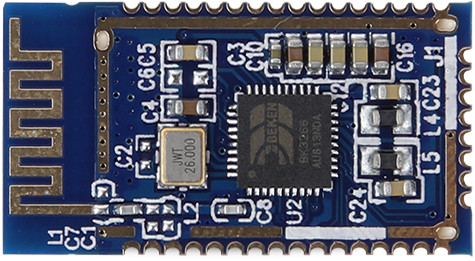Bluetooth wireless low energy (BLE) technology is the most suitable technology for wireless communication devices that have achieved low power optimization rather than maximum data rate. It requires only one-hundredth of the power consumption of traditional Bluetooth. Bluetooth low energy (BLE) peak power consumption is only a few mA, but traditional Bluetooth is more than 40 mA. Because of the power savings, BLE can operate for a few months or even years with a single button battery, depending on the application.
The main reason for Bluetooth low energy (BLE) to achieve low power consumption is to turn off its radio most of the time. Bluetooth Low Energy (BLE) scans only three signal channels, its radio only wakes up when transmitting or receiving short bursts of data, and the packet is small, only 8 to 27 octets. BLE can also be used to quickly establish connections, further reducing the turn-on time of the radio. Bluetooth Low Energy (BLE) delivers verified data in as little as 3 ms, while traditional Bluetooth typically takes 1000 ms.
At the data transfer rate, the actual data transfer rate with the highest Bluetooth low energy (BLE) is usually less than 100 kbs. Therefore, Bluetooth Low Energy (BLE) is not suitable for continuous data streaming applications that require traditional Bluetooth to provide data rates up to 3 Mbps. There are other technical differences between Bluetooth Low Energy (BLE) and traditional Bluetooth. The main differences include Bluetooth low energy (BLE) with a star-shaped network topology and 32-bit access addresses on each packet of each slave, which theoretically allows billions of devices to be in a given time Reach the connection. The traditional Bluetooth piconet topology is the opposite, with up to eight devices connected at the same time.
Other technical features of Bluetooth Low Energy (BLE) include:
Optimize GSFK modulation. Like traditional Bluetooth, Bluetooth Low Energy (BLE) also uses the GSFK modulation mechanism. However, BLE uses a higher modulation index and a 2 MHz channel to achieve a lower bit error rate, resulting in a wider transmission range.
Adaptive frequency hopping. With the device connected, BLE technology uses the same adaptive frequency hopping mechanism as traditional Bluetooth. Multiple wireless devices share the 2.4 GHz ISM band, and adaptive frequency hopping can reduce interference from other technologies in this band.
Durability. Bluetooth Low Energy (BLE) uses a single 24-bit Cyclic Redundancy Check (CRC) on each packet, which allows the header and data area to detect unit errors and 2 and 4 bit errors. Using a 24-bit CRC instead of a 16- or 32-bit CRC, the data payload of BLE can be optimized.
Strict security. Bluetooth Low Energy (BLE) is encrypted and verified using the 128-bit Advanced Encryption System (AES-128), which was developed by the US government to secure data.
Another major improvement in Bluetooth 4.1 is the dual mode capability. Devices such as sensors or mobile phone accessories typically use BLE, while smart phones and tablet devices typically act as wireless sharers, communicating via BLE and traditional Bluetooth. The Bluetooth core specification makes this dual mode operation come true. Basically, the dual mode module combines traditional Bluetooth and BLE communication stacking and allows for shared antennas. Single and dual mode components are classified as Bluetooth Smart and Bluetooth Smart Ready, respectively.
The future direction of Bluetooth low energy (BLE)
From the current point of view, BLE technology has provided an excellent solution for devices that require low-power wireless connections. However, BLE's energy efficiency will even become higher, and the Bluetooth 5.0 improvement project will make this technology easier to design for a new generation of wireless devices and smart objects to form the Internet of Things.Nowadays, Bluetooth 5.0 technology has been widely applied to various scenarios, and the low-power Bluetooth module has already been integrated with 5.0 technology.The following is the picture of BLM World Limited BT V5.0+BLE+SPP module BK3266 F-6988:


Even though Bluetooth 5.0 has these improvements, it is still backward compatible with traditional devices, including:
Support multiple roles. Changes in the link layer and dual mode topology allow the dual mode device to act as both a Smart Ready sharer and a Smart device.
High efficiency data exchange. The addition of a wire-oriented channel in the Logical Link Control and Adaptation Protocol (L2CAP) enables a large amount of data transfer between BLE devices to be more efficient while reducing the burden.
Improve the connection. Engineers will have more flexibility in establishing and maintaining Bluetooth connectivity, including automatic reconnection.
The IP architecture is structured. The new core specification adds a dedicated L2CAP tunnel to create the technical foundation for IPv6 communications, paving the way for the Internet of Things.